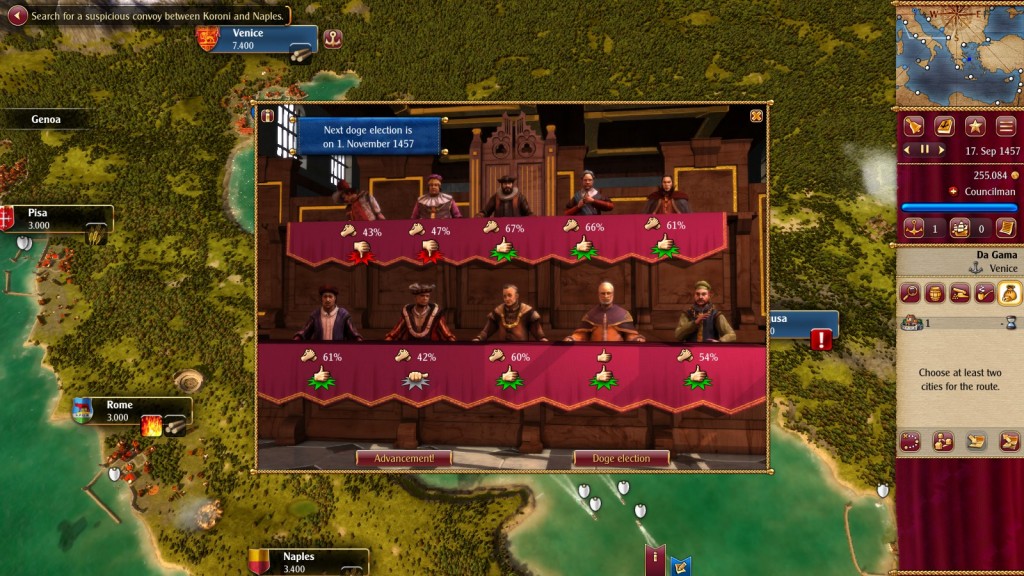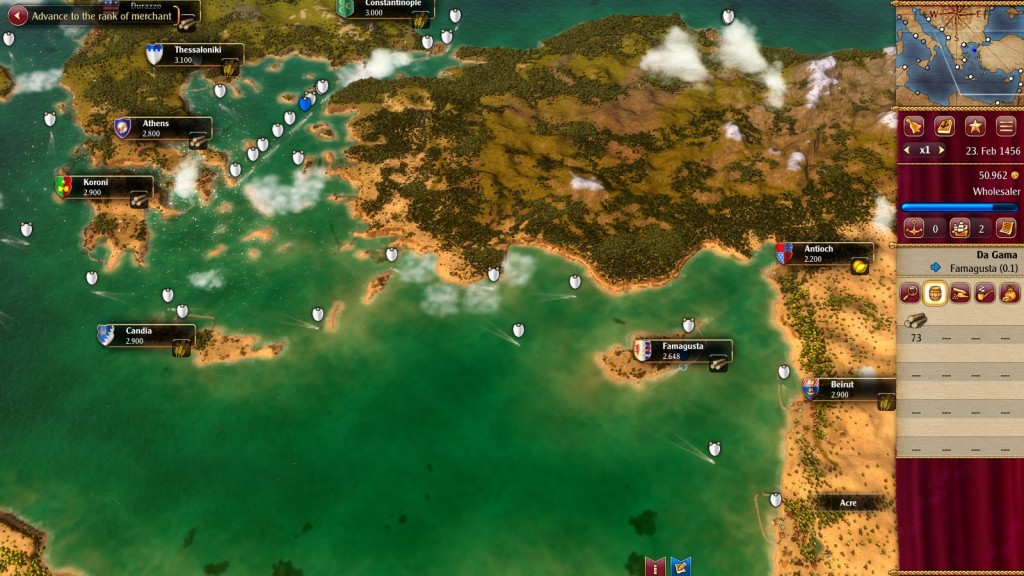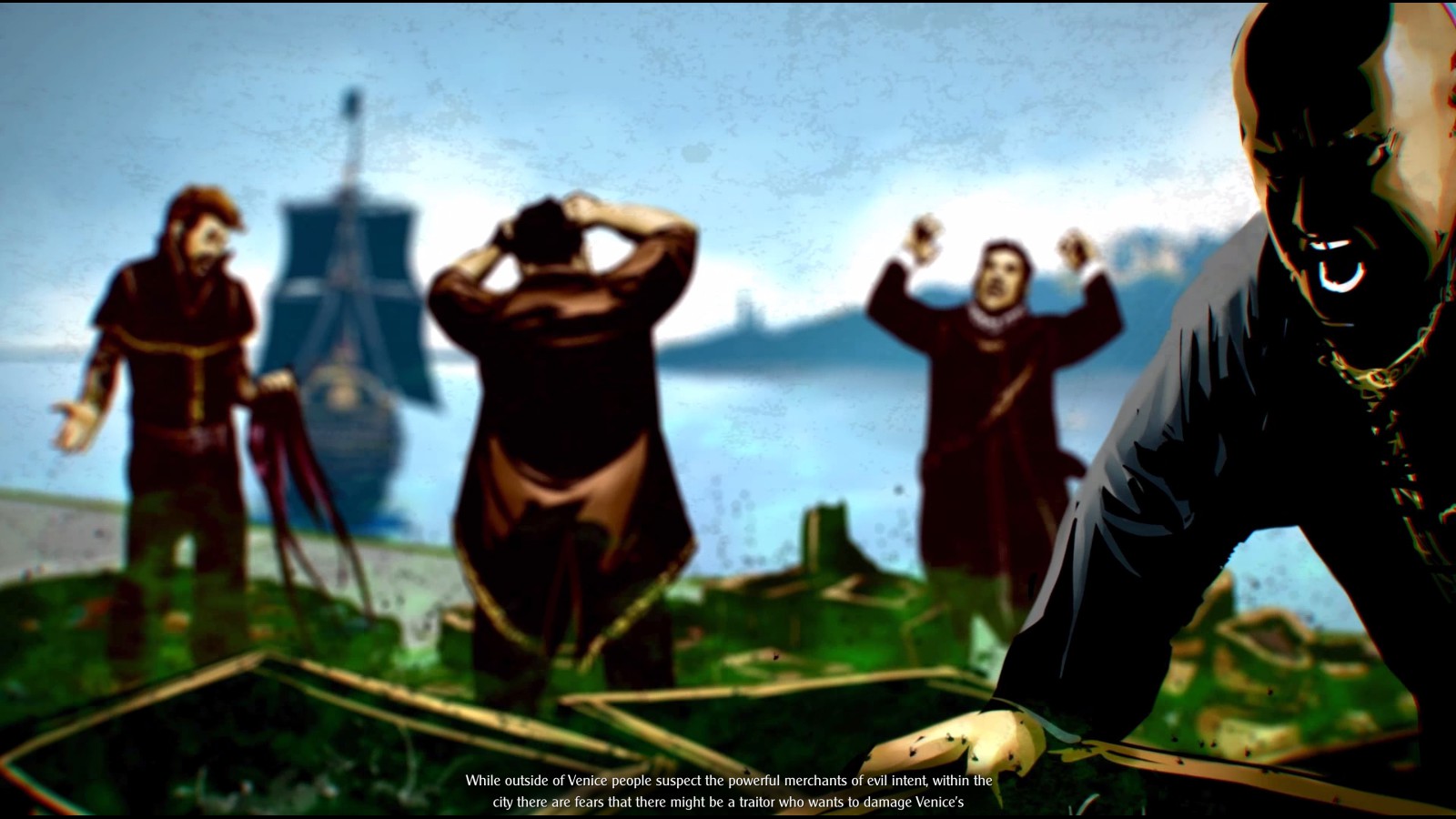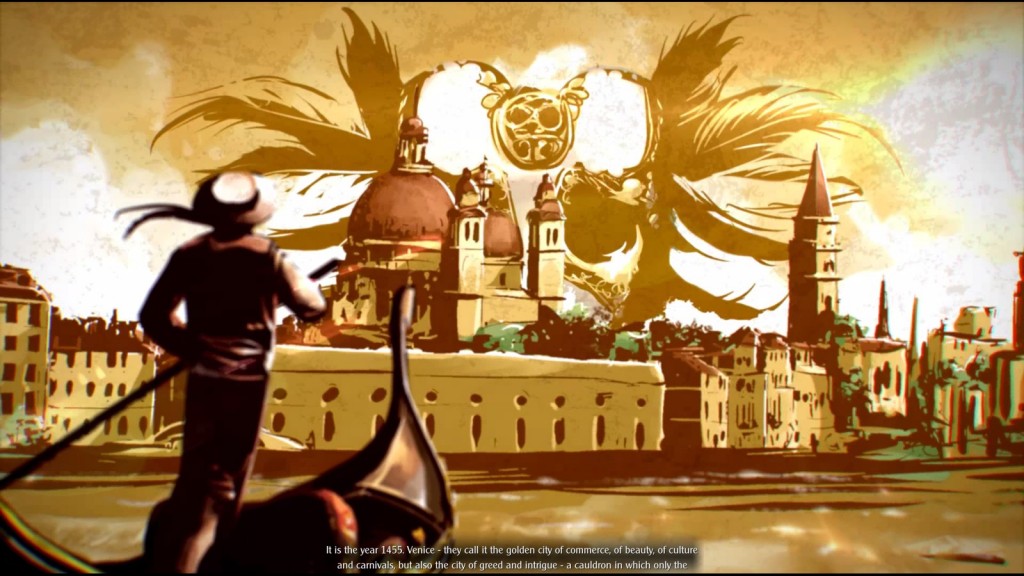Capitalism: The Game
I’ve never liked trading games, but I’ve often like the aspect of trading found in games like the Total War series and Mount & Blade: Warband. In the case of M&B:W, I once created a character that just acted as a merchant, shipping goods around the map and fending off bandits. It was fun, but eventually boring. I’ve often wondered when we’ll see a really great game which focuses on trading itself and all the politics, rivalries and complications that come with it. Unfortunately, Rise of Venice is not the great game I’ve been waiting for.
Welcome to the Business
It starts out promisingly enough – you’re a young member of a merchant family and it is up to you to improve their fortunes. You have a ship, a little money, and the game walks you through a basic trade. While it was helpful to learn how to observe the supply and demand of various cities, I was surprised to learn that it was basically the only guided tutorial in the game. After you make your first trade, your father gives you campaign missions and you go about completing them, earning money as you go and advancing your position.
You start out as a lowly Trader, and your first big mission is to gain advancement to the rank of Wholesaler. In order to do this, you need to meet certain requirements of wealth and convoy strength (number of sailors, etc.). This isn’t too complicated, but once I started managing two convoys, the whole game became an exercise in tedium. I was constantly checking various cities to see where I could make a sale or buy up stock. The process of finding this information is tedious and clicky. Plus, there was always the fun of sending a convoy to the wrong city by accident because I lost track of which one was selected while I was analyzing the market. Sailors, it turns out, still expect to get paid even when you’ve gone hundreds of miles in the wrong direction. Unions, amirite?
Trade Route Troubles and Ho-hum Politics
About three micro-managing hours into the game, I finally discovered trade routes. That is, I discovered their existence. I had no idea how to use them. I played around with the controls and kept playing for a few hours before I broke down and went to Youtube. I’ve never been this lost in a Kalypso game before, and even their franchise sequels (like Tropico 3) are full of as-you-play tutorials and clear interfaces. While there are video tutorials available via the in-game menu, I still can’t understand why they didn’t integrate how-to’s into the game itself through incremental missions or something. Passing Hour 5, I finally figured out how to use the trade routes, and I made lots of money by automating the trading process.
I went to Venice and called for an advancement vote as soon as I was eligible. Advancement means access to more goods, which were previously “greyed out” because of my lowly status. I was looking forward to trading cotton, dyes, and hemp, since those items commanded much higher prices and wider margins than the basic goods. I naturally assumed that any of the ten council members who were above 50% approval would vote my way. I learned the hard way that the threshhold is really somewhere around 55%. In subsequent votes, I would occasionally have a 52% council member vote my way, but between 50-55% is unpredictable.

Behold the might council of Venice! They hold in their hands the power to permit you to sell more stuff!
No big deal, I just kept trading and accumulating money and ships, going about my life, as it were. 30 in-game days passed, I had them vote again, and after doing a few missions for different council members, I got the necessary 5 votes needed for advancement. By this time, I had gathered enough money to be eligible for Merchant, the next rank up. I had to wait another 30 days for this vote, though.
A Big, Big World
Rise of Venice is essentially a sandbox game centered around a trading mechanic. This means you can pretty much play it however you want. You want to go around hunting pirates? Go for it. Want to build a warehouse in every major city because of reasons? You can do that (though you need at least a Merchant rank to build in any city besides Venice). Perhaps you want to get in on the manufacturing side of things, and maybe even manipulate the global economy by constricting supply whenever you want. Bottom line, Rise of Venice is a big game with lots to do, and for that, I commend its developers.
Most of the time the game’s economy swims along just fine. It gets pretty easy to figure out which cities reliably pay big bucks for different goods, and to map out a route that buys low and sells high. A negative trading route could mean one of a few things. For me, I tended to hire too many sailors (again, they work for money and not just appreciation). The economy itself presents interesting choices in which cities you choose to do business with.

There’s also a popularity level in each city, which can get you permits for building stuff. It’s a hassle, though, since most cities require you to sell them lots of stuff, which will drive the prices down so that you have to sell them at a loss.
In order to do business in a city, you need to acquire a trading license. If it’s a Venetian-allied city, it will probably be pretty cheap, around 3-5,000 gold. However, if you want to trade in North Africa, or with the Ottoman Empire, that will run you around 15K. Then there’s the Genoa-allied cities that want a bribe of 30-45k in order to trade with them. While it’s true that you could just save up your money and buy a trading license in every city, the price of the licenses seem to scale either with rank or relative to your wealth (I could never figure out which). This means its better to make the choices as the game rolls along, and to take your trading seriously to maximise your returns.
When you attain the Merchant rank, you can start building warehouses as well as productive buildings in different cities. You can have your convoys load up on manufactured goods directly from your warehouse to sell to the highest-paying cities through an automated trade route. This requires a little micromanagement since some cities have heavy emigration and need cheap labor. You can dump some sailors in the city, but doing this made me feel like some kind of Bourgeoise fat cat caricature. I know it’s a game, but still . . . what if some of those Sailor’s had virtual families? They probably had virtual girlfriends in every port. Now they’ll probably never see either again because I need more feet to press my Athenian wine.
Pettyness Begets Apathy
Another note on the game’s political front is that periodically, rival families and other traders who just don’t like you will try to hinder your progress. They’ll raid your warehouses, frame you for smuggling, and even spread rumors that you keep pet sheep. Why that last one is a problem for the fifteenth-century Venetians is never explained, though I would guess that it’s either witchcraft-related or some lost cultural anathema. Either way, it felt pretty hilarious to be barred from Venice for a few weeks because I have pet sheep.
If you’re the vindictive type, you can likewise play tricks on your enemies by hiring provocateurs and sabotaging their endeavors in pretty much the same ways. However, the whole tit-for-tat exchange with these supposed enemies felt like a waste of time for me. Venice, though a wealthy city, was never really on any of my trade routes, so their disruption to me was minimal. As for disrupting them back, I never felt like it justified the cost. I didn’t care about their shenanigans and I wasn’t about to spend 15,000 of my hard-earned gold pieces spreading rumors about their wives or whatever. As D’Angelo Barksdale once famously said, “There’s no percentage in it, you know?”
So, on the political front, this game lacks depth and seems to expect the player to do the heavy lifting by keeping track of everyone who wronged them like some kind of Count Monte Cristo. If they were doing anything that severely complicated my operations, I may have taken measures, but it never came to that. Rather than the Sopranos losing out because of a New York-influenced labor strike, I felt like nothing more than an inconvenienced motorist in a construction zone.
Combat – Canons and Cutlasses
Rise of Venice does include some Pirates in their Renaissance Mediterranean, and they are a lot of fun to fight. Unfortunately, my first attempt at combat was a complete non-starter because I hadn’t yet “organized” my convoy. I had no idea what this meant, but I eventually figured out that you can organize some of your ships in an ‘escort’ for your convoy and they will be the ships that fight pirates and other hostile forces. You can arrange sailors, ship order, and tons of other settings, but there’s also a button you can press that automatically organizes your convoy for maximum power.
The combat itself is okay, but not great. The mouse buttons are used to fire a given ship’s cannons or change their direction. Generally, the combat is pretty fun, albeit confusing and difficult to keep track of since there’s no slow-motion option. But why wouldn’t a gamer want slow motion during a naval battle? Why leave it out, when it’s an option on the campaign map? It’s hard enough to tell whether or not you’re actually winning a battle. Having to pause the fighting just to check on your ships is unintuitive and feels like I’m playing a game released seven or eight years ago. Also, controlling the cannons with the mouse without allowing for more sophisticated targeting is a step in the wrong direction.
Boarding a ship is, to put it mildly, a giant pain in the ass. This wasn’t an issue for me at first because I was content to sink the ships just to make sure I’d actually won the battle. However, I stumbled onto a mission that required me to board a ship to question its captain. It was part of some Genoese plot or something, but I don’t remember the details of the story because it took me about 7 attempts to successfully board that ship and complete the mission. And this isn’t a council member mission that I could just shrug off and make it up to him later – this was a main story mission.
A crappy boarding system in a game like this would be understandable if it were a novelty. But if a game mechanic is crucial to passing through a main mission, one which you lose the game if you can’t complete, IT HAD BETTER FREAKIN’ WORK! To board the enemy ship, you have to be behind the ship, have your ship set to boarding mode, keep your hand above the SHIFT key to slow down your ship if you need to, and click the boarding icon as it appears when you hover over the enemy ship within about a half-second window. It. Is. BULLCRAP!
Just watching this video will probably make you want to shove your fist right through your monitor. IMAGINE ACTUALLY TRYING THIS IN-GAME!
The Best of Times, The Worst of Times
All things considered, Rise of Venice is not a bad game. It is stable (something deserving recognition in a PC game), the campaign map is easy to make sense of, and trading is fairly profitable and even fun. While playing the game, there were plenty of euphoric moments when I would accomplish a mission for a council member and come one step closer to winning that next vote. Even the fetch quests had a wide enough time frame to allow for a few profitable stops along the way.
Before I conclude this review, you should know that I absolutely love history. Italian Renaissance politics is not my favorite subject, but I still find it interesting. I watched every episode of the PBS show Empires dealing with the Medici family of Florence with great interest. I have a deep abiding love for the Total War games, and I’m pretty sure I love studying and managing my economy in those games more than I like the actual fighting. In short – I am this game’s target demographic. And still, I found it lacking.
Rise of Venice’s biggest weakness is in its sandbox nature. While I’m a huge fan of expansive worlds that offer a lot of choice, those choices need to be exciting, immersive, and well-executed. In trying to be “all things to all players,” Rise of Venice instead falls repeatedly into the trap of diversified mediocrity. Nearly every individual aspect of the game, besides its central trading mechanic, has been done much better elsewhere.
The game ultimately feels unfinished because of its lacking story and unimmersive politics. Too much of the game is spectacle and it ultimately comes off as lackluster. It is an acceptable game for the same reason that a ham and cheese sandwich is an acceptable lunch – it is sufficient. It will do. It will kill boredom, but it makes no effort to really draw the player into its world of intrigue, betrayal, and Medici-style power-grabbing. Instead, it seems to hope that the player’s own niche interest will propel them to keep playing. I can personally attest that this isn’t the case.
6/10
Pros:
- Trading is fairly straight forward and easy to learn
- Big game with lots of options
- Inspired by history, which is a plus for me
Cons:
- Individual features are mediocre
- Terrible Naval combat system
- Interface is busy and difficult to learn
- Entire game nearly unplayable without the use of online tutorials





